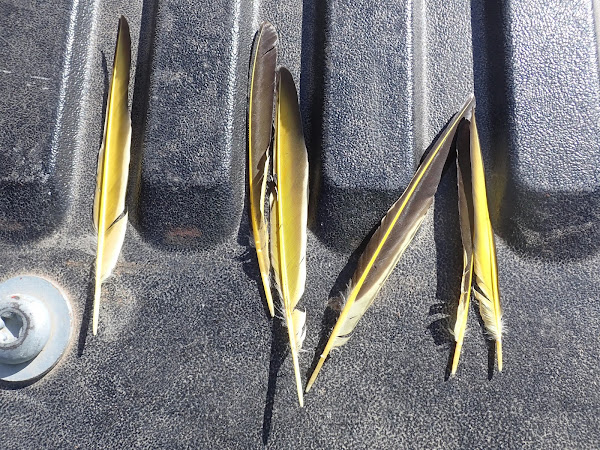 |
| Female Flicker - Wikipedia |
I found these feathers in a recently burned grass field, scattered with a lot of downy feathers. They were 5-6" long, too big for a goldfinch. I sent the question to my bird detective, Dr. Jay McEntee at MSU.
"Those are Northern (yellow-shafted) Flicker flight feathers! I believe flickers are the only birds in North America that deposits carotenoid-based colors in the feather rachises (the shafts). Carotenoids are used to make bright red, oranges, and yellows. So carotenoid pigments are what makes the red in a cardinal's feathers."
All the feather and down was within a three foot circumference in the middle of the blackened grass stubble, which looked like the kill site. There wasn't any disturbance in the periphery and the flicker should have seen any attacker coming unless it was from above. My guess was a Cooper's Hawk and I was back to Jay,
"I've seen Cooper's Hawks take woodpeckers before - they are a very likely culprit as you suggest. A flicker is a really substantial meal. They're surprisingly big "in the hand." Also, flickers like to eat ants, and the fire might have created some disturbance for underground ant nests that brought more to the surface. So as a natural history story, that all hangs together very well, in my opinion."
 |
| Lunch in the soil - Lindsay Firth |
"They eat mainly insects, especially ants and beetles that they gather from the ground. Flickers often go after ants underground (where the nutritious larvae live), hammering at the soil the way other woodpeckers drill into wood. Their tongues can dart out 2 inches beyond the end of the bill to snare prey." Cornell Lab
All About Birds says this about Cooper's Hawk. "Cooper’s Hawks mainly eat birds. Small birds are safer around Cooper’s Hawks than medium-sized birds," and goes on to list the Northern Flicker as a common victim. Feeding in an open blackened field was risky behavior. I can't prove that a Cooper's was the perpetrator but I would consider it justifiable avicide, just what it does for a living, filling its role in the food web.
===========
Breaking news:Becky Swearengin shared this flicker feather from Estes Park in September. The red shaft is a sign of the Western subspecies. "The western red-shafted flicker (C. a. cafer) resides in western North America. It is red under the tail and underwings and have red shafts on their primaries" Wikipedia



